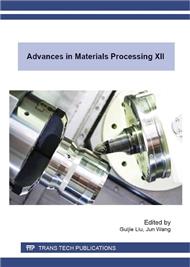[1]
A.P. Xu, Y.X. Qu, G.L. Duan, D.W. Zhang, T. Huang, Surface topography simulation algorithm based on the work piece mesh division, J. Xi'an Jiao Tong University. 35(2001) 502-505.
Google Scholar
[2]
X.Y. Liu. Biological Medical Titanium Material and its Surface Modification, Chemical Industry Press. Beijing. (2009).
Google Scholar
[3]
D.Q. Zhang , L. Luo, Z.Y. Zhang, The Impact of Vertical Milling Tool-Path on the Integrity of Work Piece Surface, J. Modular Machine Tool And Automatic Manufacturing Technique. 9 (2015) 24-27.
Google Scholar
[4]
S.Y. Pu, Metal Implant Materials and Corrosion, Beihang University Press, Beijing, (1990).
Google Scholar
[5]
A.D. Wang, Q.X. Dai, Wear and corrosion behavior of 316L stainless steel, J. Metal heat treatment. 30(2005) 33-36.
Google Scholar
[6]
S.G. Du, J.X. Ren, Z.C. Yang, Study on surface morphology and micro-structure of titanium alloy, Chin J Aeronaut . 29(2008)1710-1715.
Google Scholar
[7]
M.H. Wang, J.G. Wang, Y.H. Zheng, L. Gao, S.Y. Li, Study on surface morphology and microstructure of titanium alloy TA15 under High-speed Milling, Jichuang Yu Yeya. 42 (2014) 71-74.
Google Scholar
[8]
H.W. Zhao, S. Zhang, G.Q. Wang, B. Zhao, Effect of machining inclination angle of ball-nose end mill on surface topography, Jisuanji Jicheng Zhizao Xitong. 19 (2013) 2438-2444.
Google Scholar
[9]
D. Montgomery,Y. Altintas, Mechanism of cutting force and surface generation in dynamic milling, J Eng Ind Trans ASME. 113 (1991) 160-168.
DOI: 10.1115/1.2899673
Google Scholar
[10]
W. Tu, H.Q. Yuan, Effect of different surface implant on bone integration, J. Practical clinical medicine. 6 (2005) 138-139.
Google Scholar
[11]
Y. Zhao, X.J. Yang, Z.D. Cui, Research progress and development trend of new medical β-titanium alloy, J. Practical clinical medicine. 30 (2005) 47-50.
Google Scholar
[12]
M.A. Elbestawi, F. Ismail, K.M. Yuen, Surface topography characterization in finish milling, Int J Mach Tools Manuf. 34 (1994) 245-255.
DOI: 10.1016/0890-6955(94)90104-x
Google Scholar
[13]
Y.M. Lu, Study on the high speed milling residual height of ball head knife, J. Mould technology. 6 (2002) 13-16.
Google Scholar
[14]
J.C. Gao, Y.P. Zhang,J. Wen , Biological compatibility of the composite bio ceramic coating prepared by laser melting, J. Biological medical Engineering. 16 (1999) 20-23.
Google Scholar
[15]
Hideyuki Kuwahara, AI-Abdullat Yousel, Naoko Mazaki, Precipitation of magnesium Apatite on pure magnesium surface during immersing in Hank's solution, Mater. Trans. 42 (2001) 13-17.
DOI: 10.2320/matertrans.42.1317
Google Scholar
[16]
A.P. Xu, Y.X. Qu, W.M. Li, D.W. Zhang, T. Huang, Process model of the milling process of a flexible end milling cutter with regenerative feedback, Stroj Vest. 35(1999) 31-36.
Google Scholar


